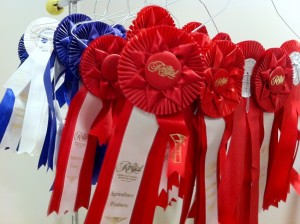The annual Royal Agricultural Winter Fair (RAWF) brings hundreds of breeders, growers, exhibitors and a handful of beekeepers to Toronto, Ontario’s Exhibition Place from November 2 through to November 11, 2012.
The fair offers a rare opportunity for growers, breeders and a Toronto urban beekeeper like me to engage in some healthy harvest competition. To this end, earlier last month I made my way to the RAWF show office to enter three samples of honey I had harvested with my fellow members of the Toronto Beekeepers Co-op. The best of the 2012 harvest was drawn from urban bee yards at the Downsview Park, The Fairmont Royal York hotel and the Toronto Botanical Garden. (see pictured L-R)
Upon arrival at the RAWF Show Office’s storage area I checked the lids of each jar to ensure no honey had splashed in transit. I delicately cradled the jars as if they were baby chicks and then handed them over hoping, with my fingers crossed, for a prize ribbon. The judging criteria for placing among the top four honey products is strictly detailed. Points are lost for an ill-fitting lid, foreign matter, visible crystals and a host of other characteristics. Retail guidelines for honey labels can be just as strict. For example, for a honey to be considered a Canada Grade A unpasteurized product it must not have moisture content more than 17.8%. Solely harvesting capped honey is the way to achieve such a standard. A retailing beekeeper will turn to the use of a refractometer to test water content and I am certain every honey judge will have this unit in their hands. Uncapped honey is best left for mead making where the water combines with honey for a sweet fermentation. All of the honey I submitted appeared uniform, matched their color class and were unpasteurized.
While backstage of the show office I discovered the coveted stash of RAWF ribbons. ( see pictured here) Some hung freshly pressed on hangers while others awaited their winning recipient from stacks of cardboard boxes.
Another measure used to grade honey is the color class tool known as “Jack’s Scale.” One would liken this to a Benjamin Moore paint sample kit. White, golden, amber and dark are the four main categories Canadian honey will fall into. The forage the bees seek dictates honey color. In general, lighter honey suggests a spring harvest. Often the darkest is drawn from the hive well after the fall golden rod has bloomed.
The darkest of the three entries I registered that day came from The Fairmont Royal York’s late harvest honey. It was entered into a “class 6” Dark category. The past four years have seen The Fairmont Royal York’s rooftop honey presented with a second, third and fourth place ribbon, but never first. As their resident beekeeper, I am proud of this legacy and we at the Toronto Beekeepers C0-op all hope for at least a repeat at this year’s Royal Agriculture Winter Fair.


